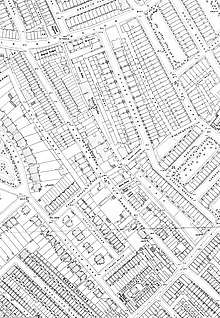Drayton Gardens
Drayton Gardens is a residential street linking the areas of Chelsea and South Kensington, London SW10. It runs roughly north to south from Old Brompton Road to Fulham Road.
.jpg)
History

Drayton Gardens was once a "rustic lane" in the hamlet of Brompton, lined with a mix of market gardens and country houses, until more suburban villas began to be built in the early 1800s.[1] Later, some of the older houses were demolished, and mansion blocks appeared, including Drayton Court in 1902, and Onslow Court in 1935.[1]
The northern half (1-39 and 4-56) formed part of the Day Estate, and was a three-acre field known as Rosehall or Rose Hawe, which the Day family acquired by the marriage in 1743 of Benjamin Day, the son of a wealthy Norwich weaver, to Ann Dodemead, daughter and co-heir of Walter Dodemead of Covent Garden.[2]
Notable buildings and residents
Rosalind Franklin, who discovered the structure of DNA, lived at number 107 (Donovan Court) until her death, and in 1992, English Heritage placed a commemorative blue plaque.[3][4]
The socialite Dorothy Fellowes-Gordon and her lifelong companion, the gossip columnist Elsa Maxwell lived there from 1912.[5]
In 1926, Margery Blackie, homeopath to Queen Elizabeth II, established a practice there.
In 1947, Bolton's Theatre Club opened in a building originally opened in 1911 as Bolton's Picture Playhouse. By operating as a club where membership was obligatory, the theatre was able to stage plays not passed by the censor, and many of its plays transferred to the West End. After closure and conversion the building was reopened in 1955 by James Quinn as the Paris Pullman Cinema which showed art-house films until its final closure and demolition in 1983. It was replaced by a block of flats.
From 1960 until his death in 1968, the author and artist Mervyn Peake lived at no 1.
Adelaide Hall, the jazz singer and entertainer lived at no 74, with her husband Bert Hicks. Sir William Arbuthnot Lane, 1st Baronet and Lady Frittie Arbuthnot Lane lived next door at no 72.
St John Philby, the orientalist and explorer, lived in Grove Court in a flat belonging to his wife Dora. It was there that his son Kim Philby, the notorious NKVD/KGB agent, betrayed Erich Vermehren to the Russians after his defection from the German Abwehr to MI6 in 1944; and where ten years later he organised the well-known press conference at which he temporarily convinced the public that he was not the "Fourth Man".
References
- Brian Girling (10 April 2014). South Kensington Through Time. Amberley Publishing Limited. pp. 118–. ISBN 978-1-4456-2158-6.
- "The Day Estate in Drayton Gardens". British History Online. Retrieved 12 December 2017.
- "Biography: Rosalind Franklin". The Royal Borough of Kensington and Chelsea. Retrieved 21 November 2014.
- "Plaque: Rosalind Franklin". London Remembers. Retrieved 27 August 2014.
- "Inventing Elsa Maxwell: How an Irrepressible Nobody Conquered High Society", By Sam Staggs, St. Martin's Press, Oct 16, 2012
External links
![]()